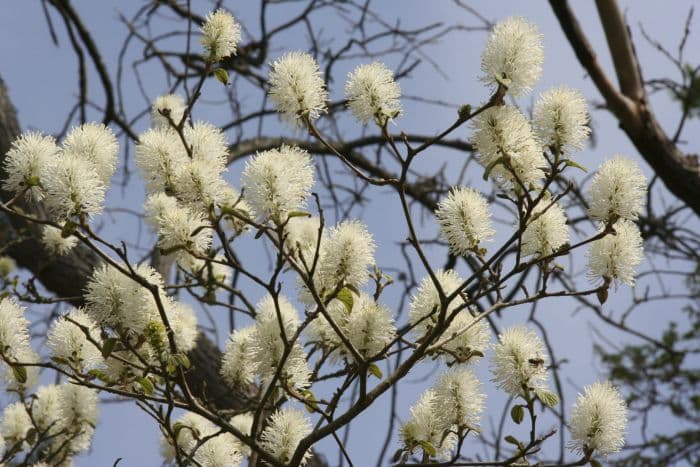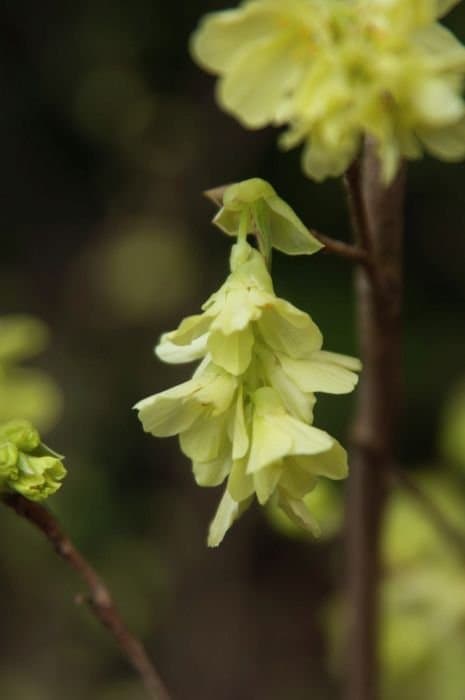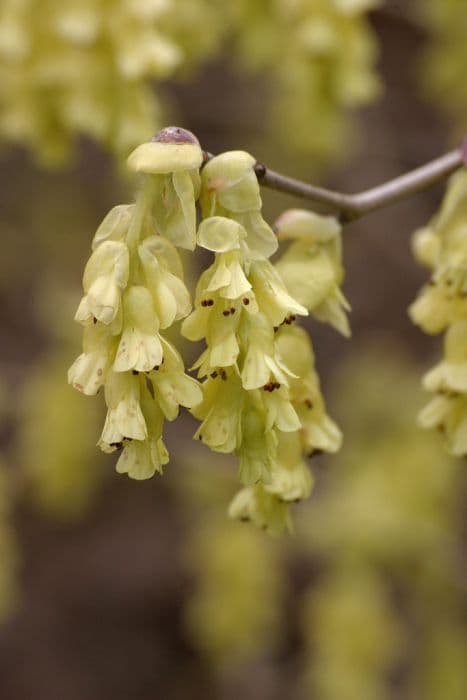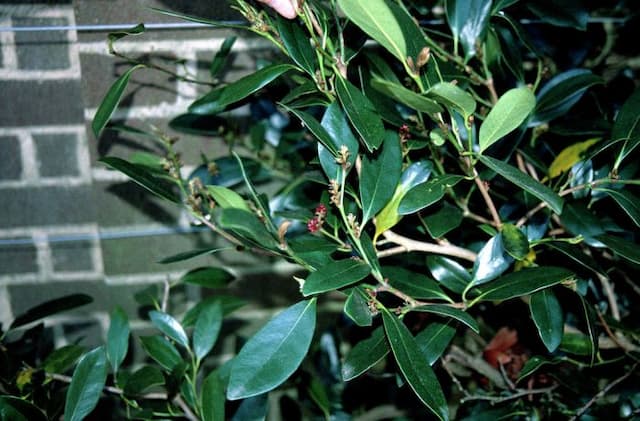Witch Alder Fothergilla major

ABOUT
The plant commonly known as large fothergilla features a bushy and rounded growth habit with multiple stems branching out close to the ground. The foliage is one of its most attractive characteristics; the leaves are broad, textured, and somewhat leathery, showcasing a deep green color during the growing season. They are uniquely shaped, resembling those of witch hazel, and in the fall, these leaves transform into a spectacular display of fiery colors ranging from yellows to oranges and reds. Springtime brings another defining trait of this plant with bottlebrush-like flowers. These blooms are composed of numerous tiny, fragrant, white flowers clustered together, each with long, conspicuous stamens that give the flower spikes a feathery, cottony appearance. The flowers are quite showy and emit a sweet scent that can be noticeable when walking near the plant. The bark is subtle compared to the foliage and flowers, with a greyish to light brown color that provides a pleasant contrast to the vibrant leaves and striking flowers. Overall, the large fothergilla has a robust, mounded shape, with dense, lush foliage and the striking presence of its unique flowers making it a standout specimen in a garden setting.
About this plant
 Names
NamesFamily
Hamamelidaceae.
Synonyms
Large Fothergilla, Mountain Witch Alder, Large Witch Alder.
Common names
Fothergilla carolina, Fothergilla monticola, Fothergilla parvifolia, Hamamelis fothergilla.
 Toxicity
ToxicityTo humans
Large fothergilla is generally not considered toxic to humans. There is no well-documented evidence of toxicity or poisoning from ingestion of this plant. However, as with any plant not intended for consumption, it is possible that some individuals might experience mild gastrointestinal upset if they consume parts of the plant. It is always best to avoid eating ornamental plants due to potential individual sensitivities and the possible use of pesticides or other chemicals on the plants.
To pets
Large fothergilla is also not recognized as a toxic plant to pets. There is no significant information to suggest that animals, such as cats and dogs, would experience poisoning from ingesting the plant. Nonetheless, it is wise to prevent pets from eating ornamental plants as a general precaution, and to avoid potential digestive disturbances or allergic reactions that might occur in sensitive individuals.
 Characteristics
CharacteristicsLife cycle
Perennials
Foliage type
Deciduous
Color of leaves
Green
Flower color
White
Height
6-10 feet (1.8-3 meters)
Spread
5-9 feet (1.5-2.7 meters)
Plant type
Shrub
Hardiness zones
5-8
Native area
Southeastern United States
Benefits
 General Benefits
General Benefits- Ornamental Value: Fothergilla major, commonly known as large fothergilla, is renowned for its decorative properties, displaying beautiful white, brush-like flowers in spring and offering vibrant fall foliage in shades of orange, red, and yellow.
- Wildlife Attraction: The plant is an attractant for bees and butterflies, which find nourishment from its flowers, while birds are drawn to the plant for shelter and its seed pods.
- Drought Tolerance: Once established, large fothergilla exhibits a good degree of drought tolerance, reducing the need for regular watering and making it suitable for xeriscaping.
- Low Maintenance: This plant is generally low-maintenance, requiring minimal pruning and care once established in the appropriate conditions.
- Pest and Disease Resistance: Fothergilla major is notably resistant to many common pests and diseases, making it a robust and enduring addition to the garden.
- Soil Adaptability: It adapts well to a variety of soil conditions, although it prefers acidic, well-drained soils, it can tolerate less ideal conditions.
- Seasonal Interest: The plant offers multi-season interest, providing vibrant color and texture to the garden throughout the growing season, from spring flowers to autumn leaves.
 Medical Properties
Medical PropertiesThis plant is not used for medical purposes.
 Air-purifying Qualities
Air-purifying QualitiesThis plant is not specifically known for air purifying qualities.
 Other Uses
Other Uses- Fothergilla major, commonly known as large fothergilla, can be used in wildlife gardens as it provides valuable nectar to bees and other pollinating insects in spring when food sources can be scarce.
- The flowers of large fothergilla are a food source for butterflies. The small size and complex flower structures are well suited for certain species of butterflies, enhancing butterfly conservation.
- Due to its appealing fall coloration, branches of large fothergilla can be cut and used in autumn floral arrangements, offering a non-traditional but aesthetically pleasing element.
- The dense, mounded habit of large fothergilla makes it a practical choice for creating low hedges or border plantings, providing structure to garden designs without the need for regular trimming.
- In larger properties or parks, mass plantings of Fothergilla major can be utilized for erosion control, as their root systems help to stabilize the soil.
- The intricate and bottlebrush-like flowers of large fothergilla can make for interesting photographic subjects, especially in macro photography, where the texture and form are highlighted.
- Large fothergilla can serve as a natural privacy screen in residential gardens due to its full habit and can provide a softer, greener alternative to fences or walls.
- Because of its tolerance for partial shade, large fothergilla can be used under the canopy of taller trees, making it a useful plant for understory landscaping and forested path edges.
- The plant's ability to thrive in a variety of soil conditions, including wetter soils, makes large fothergilla a valuable addition to rain gardens, helping to manage water runoff.
- The textural contrast between the fuzzy flower spikes of large fothergilla and other garden plants can be employed by landscape designers to create visually interesting garden compositions.
Interesting Facts
 Feng Shui
Feng ShuiThe plant Fothergilla is not used in Feng Shui practice.
 Zodiac Sign Compitability
Zodiac Sign CompitabilityThe plant Fothergilla is not used in astrology practice.
 Plant Symbolism
Plant Symbolism- Resilience: Fothergilla major, also known as witch alder, is a tough plant that can tolerate various conditions, representing the ability to withstand challenges and thrive in adversity.
- Adaptability: Witch alder can adapt to different soil types and light conditions, symbolizing flexibility and the capacity to prosper in diverse environments.
- Natural Beauty: With its attractive flowers and fall foliage, witch alder epitomizes the notion of inherent beauty and the appreciation of nature's aesthetics.
 Water
WaterThe Fothergilla major, commonly known as Large Fothergilla, requires consistent moisture but should not be waterlogged. Water the plant once a week, making sure to soak the soil thoroughly, which often translates to about 1-2 gallons for newly planted shrubs. During dry spells or hot weather, increase the frequency to twice a week. Decrease the amount during the fall and winter when the plant is dormant. Ensure proper drainage to prevent root rot.
 Light
LightLarge Fothergilla thrives in partial shade to full sun. It prefers morning sunlight with afternoon shade or filtered sunlight throughout the day. Avoid placing it in deep shade as this can affect its flowering and fall foliage color. An east- or north-facing spot that receives bright but indirect light is ideal for the optimal growth of Large Fothergilla.
 Temperature
TemperatureLarge Fothergilla is hardy and can withstand a wide range of temperatures, from as low as -10°F to as high as 90°F. However, the ideal temperature range for the plant is between 60°F and 75°F. Fothergilla major can survive occasional temperature dips below freezing, but prolonged exposure to extreme cold or heat can be detrimental.
 Pruning
PruningPrune Large Fothergilla to maintain shape and encourage healthy growth. The best time for pruning is immediately after the plant finishes flowering in late spring or early summer. This allows time for new growth, which will bear next year's flowers. Prune selectively, removing any dead or damaged branches and shaping the plant as desired.
 Cleaning
CleaningAs needed
 Soil
SoilLarge fothergilla prefers acidic soil with a pH of 5.0 to 6.0. The best soil mix should be rich, moist, and well-draining, with high organic matter content. Incorporating compost or peat moss can help achieve these conditions for healthy plant growth.
 Repotting
RepottingLarge fothergilla doesn't need frequent repotting and can thrive in the same spot for several years. Repotting every 3 to 5 years should be sufficient unless the plant shows signs of being root-bound or the soil becomes depleted.
 Humidity & Misting
Humidity & MistingLarge fothergilla prefer moderate humidity levels but are adaptable to different conditions. Maintaining a humidity level of around 40-50% will support healthy growth for this plant.
 Suitable locations
Suitable locationsIndoor
Place in bright indirect light, acid soil, regular water.
Outdoor
Plant in partial shade to full sun, acid soil, mulch well.
Hardiness zone
5-9 USDA
 Life cycle
Life cycleFothergilla major, commonly known as large fothergilla, begins its life cycle with seed germination occurring in the spring, requiring a period of cold stratification to break dormancy. Following germination, the seedling grows and establishes a root system, and the young plant develops its distinctive foliage. As the plant matures, it undergoes vegetative growth annually, producing erect stems and deep green, leathery leaves that exhibit showy fall coloration ranging from yellow to deep red. Large fothergilla reaches flowering maturity typically after a few years, producing creamy white, bottlebrush-like flowers in the spring before the leaves fully emerge. After pollination, often by insects attracted to the fragrant blooms, the plant sets seeds that are encased in small, woody capsules which then disperse when mature. The shrub continues this cycle of growth, flowering, and dormancy annually, often thriving for many years with proper care in well-drained, acidic soils.
 Propogation
PropogationPropogation time
Spring-Early Summer
The most popular method for propagating Fothergilla major, commonly known as large witch alder, is through softwood cuttings. This is typically done in late spring to early summer when new growth is still flexible and has not yet hardened. To propagate, a gardener would take cuttings of about 4 to 6 inches (10 to 15 centimeters) from the tips of healthy branches, making sure each cutting has several sets of leaves. The lower leaves are removed, and the cut end is dipped in rooting hormone to encourage root development. The cuttings are then inserted into a well-draining soil mix, ensuring at least one set of leaves is above the soil surface. The container with cuttings is kept under high humidity and in indirect light until roots have established, which typically takes a few weeks. Once rooted, the new witch alder plants are gradually acclimated to outdoor conditions before planting in their final location.









